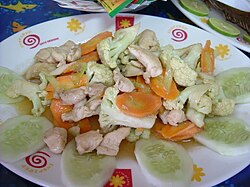

|
m removed Category:Min Nan words and phrases using HotCat article about the dish, not the phrase
|
m →top: clean up infobox image; caps
|
||
| Line 1: | Line 1: | ||
{{Infobox food |
{{Infobox food |
||
| name = Cap cai |
| name = Cap cai |
||
| image = |
| image = Cap Cai.JPG |
||
| image_size = 250px |
|||
| caption = Cap cai |
| caption = Cap cai |
||
| alternate_name = |
| alternate_name = |
||
| Line 15: | Line 16: | ||
}} |
}} |
||
'''Cap cai''' sometimes spelled ''' |
'''Cap cai''' sometimes spelled '''cap cay''' ({{zh|c=雜菜|p=zácài|poj=cha̍p-chhài|l=mixed vegetables}}) is the [[Hokkien]]-derived term for a popular [[Chinese Indonesian]] stir fried vegetable dish that originates from [[Fujian cuisine]]. |
||
Various vegetables such as [[cauliflower]], [[cabbage]], [[Chinese cabbage]], [[Napa cabbage]], [[carrot]], [[baby corn]], [[Auricularia auricula-judae|mushroom]], and [[leek]] were chopped and stir fried in a wok with small amount of cooking oil and water, added with chopped [[garlic]] and [[onion]] with [[salt]], [[sugar]], [[soy sauce]], ''ang ciu'' Chinese [[cooking wine]] and [[oyster sauce]] for taste. The liquid sauces were thickened using [[maizena]] (corn starch). Cap cai could be made as [[vegetarian]] dish, or mixed with meats such as chicken meat, liver or gizzard, beef, fish, shrimp or cuttlefish, and slices of beef or fish ''[[bakso]]'' (meatballs). The type and numbers of vegetables differ according to recipe variations and the availability of vegetables in each household, but the most common vegetables in simple |
Various vegetables such as [[cauliflower]], [[cabbage]], [[Chinese cabbage]], [[Napa cabbage]], [[carrot]], [[baby corn]], [[Auricularia auricula-judae|mushroom]], and [[leek]] were chopped and stir fried in a wok with small amount of cooking oil and water, added with chopped [[garlic]] and [[onion]] with [[salt]], [[sugar]], [[soy sauce]], ''ang ciu'' Chinese [[cooking wine]] and [[oyster sauce]] for taste. The liquid sauces were thickened using [[maizena]] (corn starch). Cap cai could be made as [[vegetarian]] dish, or mixed with meats such as chicken meat, liver or gizzard, beef, fish, shrimp or cuttlefish, and slices of beef or fish ''[[bakso]]'' (meatballs). The type and numbers of vegetables differ according to recipe variations and the availability of vegetables in each household, but the most common vegetables in simple cap cai are cauliflower, cabbage and carrot. |
||
==See also== |
==See also== |
||

Cap cai
| |
| Course | Main course |
|---|---|
| Place of origin | Indonesia |
| Created by | Chinese Indonesians |
| Serving temperature | Hot |
| Main ingredients | Stir fried vegetables |
| Variations | Cap cai kuah (soupy) and Cap cai goreng (dry) |
Cap cai sometimes spelled cap cay (Chinese: 雜菜; pinyin: zácài; Pe̍h-ōe-jī: cha̍p-chhài; lit. 'mixed vegetables') is the Hokkien-derived term for a popular Chinese Indonesian stir fried vegetable dish that originates from Fujian cuisine.
Various vegetables such as cauliflower, cabbage, Chinese cabbage, Napa cabbage, carrot, baby corn, mushroom, and leek were chopped and stir fried in a wok with small amount of cooking oil and water, added with chopped garlic and onion with salt, sugar, soy sauce, ang ciu Chinese cooking wine and oyster sauce for taste. The liquid sauces were thickened using maizena (corn starch). Cap cai could be made as vegetarian dish, or mixed with meats such as chicken meat, liver or gizzard, beef, fish, shrimp or cuttlefish, and slices of beef or fish bakso (meatballs). The type and numbers of vegetables differ according to recipe variations and the availability of vegetables in each household, but the most common vegetables in simple cap cai are cauliflower, cabbage and carrot.
This food-related article is a stub. You can help Wikipedia by expanding it. |
|
| |||||||||||||
|---|---|---|---|---|---|---|---|---|---|---|---|---|---|
| Common dishes |
| ||||||||||||
| Snacks |
| ||||||||||||
| Desserts |
| ||||||||||||
| Drinks |
| ||||||||||||
| Condiments |
| ||||||||||||
| |||||||||||||